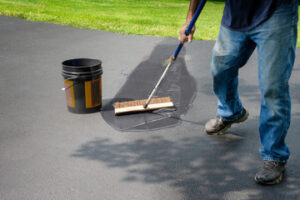A properly installed and maintained landscape lighting system can work well for years. However, if the fixtures and lamps are of poor quality or have reached their end of life, it may be time to replace the lighting system.

First, turn off the power at the transformer or breaker box. This is a safety precaution. Connect with Landscape Lighting Repair Orlando for reliable help.
Landscape lighting is an excellent way to accentuate your home or business and increase curb appeal. It’s also a great way to deter crime by illuminating dark areas and making it more difficult for criminals to hide. However, if your landscape lights aren’t functioning properly, it can impact the overall look of your property.
Luckily, many of the most common landscape lighting repair issues can be fixed at a relatively low cost. The first thing to do is to ensure that the system is receiving power. This can be done by examining the transformer and checking for signs of damage. In addition, the wires should be checked to make sure that they are buried properly. Ideally, the wires should be buried at least 3 inches deep. If they are exposed, it is likely that the wires will experience moisture problems which can lead to failure.
The next step is to check for damaged fixtures and replace any burned out bulbs. Additionally, it is important to replace the bulbs with ones that are matched to the original specifications of the lighting system. This will help ensure that the lights are achieving even illumination. Lastly, it is important to trim any vegetation that has overgrown around the lighting fixtures. This will help prevent plants from blocking the light or damaging the fixture.
It is important to hire a professional landscape lighting repair company when addressing electrical wiring issues. A qualified professional will understand how to follow proper safety procedures and will be able to safely diagnose the problem and repair it. Inexperienced DIYers who attempt to fix landscape lighting problems on their own could end up causing more damage or even creating a dangerous situation that puts the homeowner or their family in danger.
A well-maintained landscape lighting system will last longer than one that is neglected, which can save the owner money in the long run. Proper maintenance can also allow the owners to consider upgrades in the future when they are ready to invest in new technology. For these reasons, it is crucial to schedule regular maintenance appointments.
Peace of Mind
Landscape lighting is a beautiful way to highlight plants, show off your garden or brighten up your home’s exterior. It adds curb appeal and increases your property’s resale value. But just like anything else, it needs some maintenance to keep it looking its best. With a little bit of TLC, your outdoor lighting can continue working as it did the day it was installed.
Lights are a big investment, and you want to be sure that it continues to work as it should. That’s what proactive maintenance is all about. Some of the tasks that are performed during this process include resetting time clocks for settings that go on/off at different times, trimming or pruning around fixtures and re-burying any wire runs that have worked their way up. Getting your lights in the right position and clean is also part of the process.
Not only will lighting add beauty to your home but it can also help with safety. Well-lit pathways and driveways can reduce the chance of tripping and falling, especially for elderly loved ones or young children. It also helps to deter criminals from targeting your home as they’ll be more likely to be detected by the lights.
If you’re considering adding a lighting system to your home, it’s important to find the right specialty residential contractor. Look for one that offers warranties on fixtures and maintenance plans. It’s also a good idea to look at reviews and compare prices. This can help you make the best decision for your budget and needs. Once you have found a company that meets your requirements, contact them to discuss your project and get a quote. Then you can rest assured that your lighting will continue to shine for years to come.
Safety
Lighting fixtures are a great way to highlight your home and landscape, but they’re also at risk of damage from various environmental factors. Fortunately, many of these issues are preventable with regular maintenance. Inspecting your landscape lighting system for problems is a simple process. The most common problem is that a fixture is not working because it has a broken light bulb or socket. If you try replacing the bulb but it still doesn’t work, it may be time to consider a different fixture. If you’re having ongoing socket problems, it may be a sign of a fixture design flaw that causes moisture to get inside the electrical components.
Another common landscape lighting repair issue is a power failure caused by faulty wiring or improperly sized wire. Using the proper wire size is critical to a functioning lighting system, and it’s important to inspect the wire regularly for signs of wear. If the wire is soiled or damaged, it should be replaced immediately. Similarly, if the system is constantly tripping the circuit breaker, it may be necessary to replace the transformer.
While these issues are fairly obvious, they’re not always easy to spot. Some lighting problems don’t manifest as a clear outage, and they can be difficult to diagnose without the help of a professional. Having your landscape lighting repaired by professionals is the best way to avoid any costly repairs down the road.
Before you attempt a landscape lighting repair, make sure you’re wearing the appropriate safety equipment. A hard hat is essential to protect your head from falling debris, and work gloves and steel-toe boots are also recommended for handling electrical wires. When cutting and stripping cable, it’s important to use proper technique to ensure that the strands don’t get tangled or caught on anything that could trip the circuit breaker.
Increased Value
A landscape lighting system is an investment in your home, enhancing the curb appeal of your property while providing increased safety and security. But like any other investment, it requires regular maintenance and repair to retain its value and functionality over time. Fortunately, there are many benefits to investing in landscape lighting repair.
Maintaining Your Lighting
Landscape lighting fixtures are constantly exposed to the elements, making them susceptible to dirt and debris build-up that reduces the quality of light output. This is why it’s important to clean your lights and fixtures on a regular basis. Typically, metal and plastic components can be cleaned using a soft rag and soapy water or a gentle glass cleaner. Likewise, the lenses on glass fixtures should be regularly cleaned using a mild solution, such as CLR, to restore their transparency and prevent fogging.
In addition to cleaning fixtures, a significant part of routine maintenance is operations monitoring. This involves checking the power supply, inspecting transformers, and examining wiring to ensure that everything is functioning properly. This helps to identify small problems before they escalate, such as blown fuses or circuit breakers.
One of the most important parts of landscape lighting maintenance is replacing bulbs. Over time, bulbs can burn out, so it’s important to replace them before they become dim or completely nonfunctional. Replacing bulbs is also a great opportunity to upgrade your lighting to something more energy-efficient, as LEDs use less power than traditional incandescent bulbs.
Another important component of maintenance is repositioning and straightening lights as necessary. Over time, the plants and trees on your property will grow, shed leaves, or change shadows, causing some lights to lose their optimal position. Additionally, frequent strong storms can result in some lighting equipment being knocked off course. Regularly straightening and repositioning lights ensures that they are always illuminating your desired areas effectively.
If your landscape lighting system is over 15 years old, it may be time to consider an upgrade. Not only have outdoor lighting options come a long way in recent years, but an older system can be more difficult to maintain and may not provide the same level of functionality as newer models.

